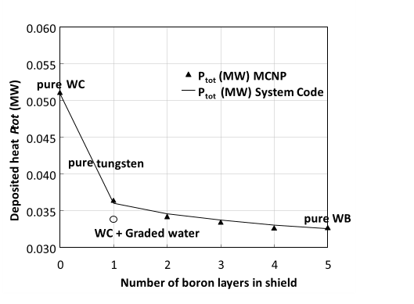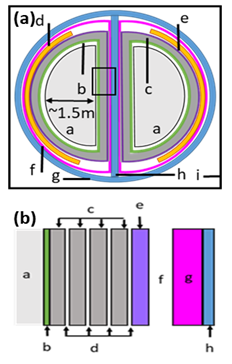The cWC-RSB concept
The first set of radiation dense materials: cWCs and RSBs
cWC-RSB materials are the first selection of radiation dense materials that are to be studied by this group.Cemented Tungsten Carbides (cWCs) are a well-established engineering material since the 1930s, and used in a wide variety of applications including metal cutting, rock-drilling and rotary cutting. The combination of WC ( 0.5 μm < dwc < 10 μm) as a refractory hard phase along with a ductile metal binder (6 - 25% wt%) after liquid phase sintering ( 1350oC < T < 1500oC).
The commonest binder metal for cWCs is Co with Ni being less commonly used. The use of Co and Ni as a binder alloy limits their use in a radioactive environment due to the highly activating nature of Co and Ni.Fe-Cr alloy has similar properties for Co and Ni and does not activate significantly and enables the use of FeCr-cWCs as a candidate radiation shielding material for the first time. The radiation response of cWC materials is in the earliest stages of investigation and is one of the goals of this group.
Reactive Sintered Borides (RSBs) were developed from experiments with adding boron to FeCr-cWCs to improve oxidation resistance. This research showed that dense RSB bodies with similar shrinkage to cWCs could be sintered as for cWCs if composed of a mixture of B4C, FeCr alloy and W metal where the atomic ratio of W : Fe : B is close to 1 : 1 : 1. Considerable research on RSB materials is required on processing and their radiation response is still mostly unknown with all current studies based in silico.
Basic thermomechanical properties of cWCs are shown below:
(a) (b)

(a) Fracture Toughness by metal binder weight and (b) Thermal conductivity for different types of cWCs ©Sandvik AB
The Promise of RSBs - Neutron Shielding in a Compact Spherical Tokamak (cST)
RSBs have shown promise as candidate shielding materials in terms of their low-energy neutron-absorbing properties which contributes significantly to the heat deposited into the superconducting magnets [Windsor, C. G. et al. Nucl. Fusion 57, 036001 (2017). Windsor, C. G. & Morgan, J. G. Nucl. Fusion 57, (2017).Windsor, C. G. et al. Nucl. Fusion 58, (2018)].

Attenuation of neutron and gamma radiation of different energies from cWC (A10, blue) and RSB (B5.5, red)

The high absorption of thermal neutrons by RSBs mean that combined cWCs-RSB shield may yield unrivalled attenuation properties – outperforming even metallic tungsten [Windsor et al Nucl. Fus. 57 (2017) 36001] as shown in this simulation of power deposition into a tokamak core from different shielding configurations.
The challenge: Fusion power
The first practical problem for which radiation dense materials intends to solve is practical fusion power.
Current solutions are mostly based on W-metal based solutions which are sufficient for use in experimental reactors. The engineering requirements for proposed power-generating fusion reactors still exceed the properties of current candidate materials. [Hancock et al J. Nucl. Mater. 512, (2018) 169, Di Pace et al Nucl. Fusion 57 092003 (2017).

Schematic diagram of spherical tokamak. (a) plasma chamber, (b) Plasma facing component (PFC), (c) neutron shield, (d) tritium breeding blanket. (f) High Temperature Super Conductor, (g) vacuum chamber, (h) steel support and (i) outer shield. (b). Schematic diagram of the central column from Figure 1(a) (black outline). (a) plasma, (b) PFC component, (c) cWC-based neutron shields, (d) coolant/moderator channels, (e) RSB inner shield (f) vacuum gap, (g) HTS and (h) steel support.
